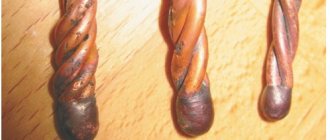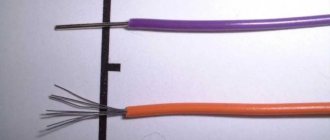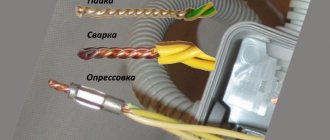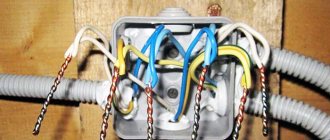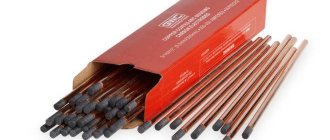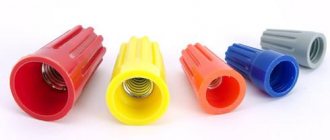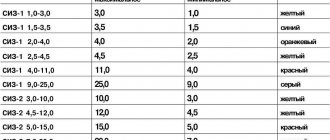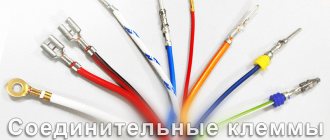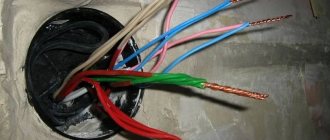Even in specialized forums and online communities, professional electricians cannot come to a consensus on a simple and effective way to connect copper and aluminum in household wiring.
What can we say about the ordinary home craftsman who encounters electricity from time to time. It is for such beginners that I review six popular methods of creating reliable electrical contact, showing their differences.
All you have to do is read the article on the site and choose for yourself the method that requires less effort and is easier to perform in order to ensure high electrical safety.
Electrochemical corrosion
You can often come across statements that it is undesirable to combine copper and aluminum into one whole. From the point of view of material compatibility, these are fair statements. What about combining copper and galvanized or steel and silver? There are many options for metal pairs, and it is difficult to remember which ones are compatible with each other and which ones are not. To simplify the task, there are special tables, one of which is presented below.
Table of electrochemical potentials (mV) arising between connected conductors.
To understand the issue, you need to know what processes occur when different conductors of electricity touch each other. If there is no humidity, the contacts will be reliable in any case. However, in practice, such a situation is impossible, since there is always moisture in the atmosphere, which disrupts the connections.
Every conductor of electricity has some electrochemical potential. This circumstance is used by humans for practical purposes, for example, accumulators and batteries operate on the basis of different potentials.
When moisture gets on contacting metal surfaces, a short-circuited galvanic environment occurs and one of the electrodes is deformed. One of the two metals is destroyed in the same way. Thus, to determine the compatibility of metals, it is necessary to have information about the electrochemical potential of all materials involved in the reaction.
What happens if copper is combined directly with aluminum?
According to technical regulations, mechanical joining of metals is permitted if the electrochemical voltage between the two materials is not higher than 0.6 mV. For example, from the table above, it can be established that in the case of joining aluminum and copper, the electrochemical potential is 0.65 mV, which is significantly higher than when joining the same copper with duralumin (0.20 mV).
And, nevertheless, if you really need it, you can also combine materials that are not entirely compatible, such as copper and aluminum . How to connect copper and aluminum wires will be discussed below.
Self-clamping terminals
It is even faster and easier to connect aluminum and copper conductors using self-clamping terminals.
The stripped conductors must be inserted into the terminal holes until they stop. There they will be automatically fixed with the help of pressure plates (it will firmly press the conductor to the tinned busbar). Thanks to the transparent housing of the terminal block, you can check whether the core has fully entered the terminal. The disadvantage of such devices is that they are disposable.
If you want a reusable clamp, use lever terminals. The lever rises and releases the entrance to the hole into which the stripped core must be inserted. After which the lever is lowered back, thereby fixing the conductor in the terminal. This connection is detachable; if necessary, the lever is raised and the wire is removed from the terminal.
Self-clamping terminals “WAGO” have proven themselves best in the electrical goods market. The manufacturer produces a special series of terminals that contain “Alu-plus” contact paste. This substance protects the contact junction between aluminum and copper from the manifestation of electrolytic corrosion processes. You can distinguish these terminals by the special marking on the packaging “Al Cu”.
Using such terminals is also extremely simple. The clamp itself indicates how long the insulating layer of the conductor needs to be stripped.
The advantages and disadvantages of using WAGO terminal blocks are described in this video:
Overview of connection methods
Several methods are used to connect aluminum and copper wires. Moreover, in each of the described cases, special devices will be needed. Let's consider each type of docking separately.
Bolted connection
This type of connection is the most common because it is simple and cheap. If done correctly, a wired connection using nuts and bolts will ensure reliable contact for the entire life of the wiring and electrical devices. In addition, you can always disassemble the connection, connect additional conductors, etc. Thanks to the threaded connection, the relevance of electrochemical incompatibility of metals is lost, and it becomes possible to join aluminum and copper, thick and thin wires, stranded and single-core. It is important to avoid direct contact between dissimilar materials by making gaskets from spring washers.
To do the job you will need a bolt and nut, as well as a washer (it must be made of anodized steel).
The connection is made as follows:
- We remove the insulating layer from the wires to a short length (about four bolt diameters). We also strip the conductor, especially if its cores have been oxidized. We form rings from the veins.
- First, an aluminum conductor is screwed to the bolt in one girth.
- We put on the puck.
- Now it’s the turn of the copper conductor. We also screw it in one turn.
- Next, screw the nut in such a way as to achieve a reliable connection.
Note! If the docking is carried out for operation in a room where, according to technical conditions, there is vibration, an additional nut will be required for a high-quality result.
Terminals
There are several options for terminal connections. One option is the so-called “nuts”. Such an unusual name for terminal blocks is due to their external resemblance to nuts. Several types of “nut” terminals are available.
The most primitive model in its design has three demarcation plates inside. The conductors are located between the plates. In this way, direct contact between dissimilar materials is avoided. At the same time, the “nuts” allow you to maintain the supply circuit of the electrical circuit.
To achieve the integrity of the circuit, it is necessary to strip the supply conductor from the insulating layer, unscrew a couple of bolts, install the bare wire between the plates and tighten the bolts again. The insulator must be removed from the outlet ends, and then the wires must be directed into holes located perpendicular to the inlet channel. Next, the conductors are fixed between other delimiting plates.
There is also a more complex model on the market, the design of which is designed in such a way that there is no need for cutting conductors. The fact is that the plates of the device contain teeth, which, when squeezed by bolts, simply tear the insulating layer. The described docking option is considered very reliable.
There is another option for terminal blocks - ordinary blocks. The device is a strip with terminals. To connect two dissimilar materials, you need to strip their ends and route the wires into the terminals. The ends are secured with bolts that are located on top of the terminal holes.
Wago terminal blocks
Connecting copper and aluminum wires can be done using Wago terminal blocks. This device belongs to the above-mentioned terminals, however, we should talk about the Wago pads in a little more detail due to their popularity among buyers.
Wago comes in two versions: disposable with a non-removable wire and reusable - with a lever that allows repeated installation and removal of the conductor.
Note! Wago terminal blocks are recommended for use only in lighting devices. If the load is too great, the contact spring will overheat, resulting in broken contacts between the conductors and the plates.
Wago is used for all types of single-core wires whose cross-section is between 1.5 and 2.5 square millimeters. The block can be used in distribution boxes with a current strength of up to 24 amperes. However, in practice it is believed that 10 amperes is more than enough and higher values will lead to overheating.
To connect the conductors, you need to force one of them into the block hole, as a result of which it will be securely fixed there. To remove the conductor from the hole, you will also need to apply force. It should be borne in mind that as a result of removing the wire from the disposable terminal block, the contact may be deformed, so the next time reliable contact is not guaranteed.
It is much more convenient to use a reusable Wago device. A characteristic feature of this terminal block is the presence of an orange lever. Using such a device, you can connect or disconnect all types of wires with a cross-section from 0.08 to 4 square millimeters. The permissible current level is 34 amperes.
To create a connection, you need to remove 8-12 millimeters of insulation from the wire, lift the lever upward, and direct the wire into the hole in the terminal block. Next, return the lever to the reverse position, thereby fixing the wire in the terminal.
The only significant drawback of Wago is its higher cost compared to traditional terminals.
Rivets
This method of joining dissimilar conductors resembles a bolted one. However, instead of a nut and bolt, a rivet is used to form a permanent connection. In other words, once fixed, it is no longer possible to remove the rivet without damaging it.
To make the connection, we strip both conductors of insulating material, and also bend the wires into rings. Next, we string one of the rings onto the rivet, after that we put on a steel washer, then we string the ring again, but with the second conductor.
The rivet has a head on one side. Now you need to flatten the second side, thereby forming a second cap, which will act as a fastener. The deformation of the rivet is carried out either with a hammer or with a special tool similar to pliers. The method of joining with rivets allows you to obtain a very high-quality connection.
Soldering iron
If desired, you can solder two dissimilar metals. However, this will require compliance with some technological nuances.
As for copper, there will be no problems with soldering, but with aluminum the situation is more complicated. The fact is that as a result of soldering and under the influence of oxygen, an amalgam appears on the metal surface. This alloy film is incredibly chemically resistant, which is why it does not form adhesion to solder. To remove the film you will need a solution of copper sulfate, a Krona battery and a piece of copper wire.
On the aluminum wire, we clean the area for soldering, and after that we apply a little vitriol there. We fix the aluminum wire on the negative pole of the battery, and fix the copper wire with one end on the positive pole, and put the other end in copper sulfate. After some time, the aluminum will be covered with a copper layer, onto which a copper conductor can be soldered.
WAGO terminal blocks
WAGO clamps consist of a self-clamping metal plate treated with anti-oxidation paste and a dielectric housing. Aluminum and copper wires are inserted into adjacent holes and pressed against one plate. Thus, the materials do not come into contact with each other and do not oxidize.
WAGO clamps are used mainly for groups of lighting devices, since with a high current load the plate can often burn out and the clamp itself can melt. Please note that the maximum cross-section of wires for WAGO clamps is 2.5 mm2, so we do not recommend installing a core thicker than this.
The advantage of WAGO terminal blocks is the speed of installation and compact dimensions, thanks to which the connections can be easily installed in the junction box. However, WAGO is quite expensive in terms of cost, and with a large number of connections it will cost its owner a pretty penny.
Connection quality
In most of the previously discussed cases, rigid fastening of conductors stripped of the insulating layer is used. However, when joining copper and aluminum, one important technological nuance must be taken into account: aluminum, under the influence of load, acquires plasticity, as experts say, it begins to “flow” . As a result of this process, the connection weakens, and therefore the bolts need to be tightened regularly. If you do not tighten the bolts in time, the terminal may simply catch fire due to severe overheating.
Consequences of contact between copper and aluminum
Let's consider the possible consequences using the example of a simple battery. Inside it there are 2 electrodes and an electrolyte. When metals interact, chemical processes occur and current is consumed or generated.
Some metals have oxidizing properties, while others have reducing properties. Their capabilities are indicated in the electrochemical voltage series. The degree of activity increases in one direction and decreases in the other. Here you can see compatible and incompatible contacts.
The farther apart metals are located in the electrochemical series, the greater the voltage between them will arise during a chemical reaction. The result of this will be the destruction of the metal located to the left.
If we compare nickel and cadmium, they are located nearby (through one element). The destruction of the latter occurs slowly; batteries or accumulators have a long service life.
Aluminum and copper have a big difference in the formation of stresses, so Al, located much to the left, will quickly collapse. A layer of oxides actively forms on its surface, which leads to deterioration of the contact and its overheating.
Useful tips
There are a number of rules that you can follow to achieve a quality connection:
- Conductors with multiple cores should not be clamped too tightly. The wires in such wires are too thin, they easily break under pressure. The consequence of ruptures is an overload on the remaining wires, which can lead to a fire.
- It is important to choose the right terminal taking into account the cross-section of the conductor. If the channel is too narrow, the conductor will not fit, and if it is wide, it will fall out.
- Brass sleeves and terminals are very fragile, so do not clamp them too hard.
- You should pay close attention to the markings, which indicate the maximum possible current strength. Moreover, it is better not to achieve this indicator, limiting yourself to no more than 50% load.
Note! It is not recommended to buy unnamed products made in China. Connectors are too important a part to skimp on. It is best to give preference to products from well-known companies (Swiss can be taken as an example).
Adapters for connecting from aluminum to copper
Sleeve adapters for crimping are considered the most reliable and high-quality connection. Special copper-aluminum models are made, into which 2 wires are inserted, after which they are processed with a press. However, it should be noted that the sleeves require sections starting from 16 mm2, while in residential buildings from 1.5 to 4 mm2 are used. Therefore, it is better to connect using a standard aluminum sleeve. Pressure testing occurs according to the following algorithm:
- We strip the ends of the copper conductor with lead-tin solder - this helps prevent metal-to-metal contact.
- Get rid of aluminum oxide film.
- Pass the wires through from different ends and crimp them.
- Wrap the connections with electrical tape or heat shrink followed by heating.
Important! If excessive crimping is done inside the structure, the soldered layer at the copper end may be damaged, so the size of the sleeve and matrix must match the core.
The good thing about the adapter from aluminum to copper is that it can be embedded under the plaster without fear of the wiring catching fire. However, implementation will require a press, which entails certain costs.
Sleeves
It is recommended that when carrying out work, all electrical wiring is intact, without breaks or connections - this reduces the risk of fire. However, if there is an urgent need to join a copper and aluminum core, then you need to take into account all the recommendations and choose one of the most optimal methods.
Stranded wires
As mentioned earlier, conductors with many cores should not be overly pinched. To connect stranded wires, sleeves or ordinary twists are most often used. We'll talk about these methods in a little more detail below.
Sleeves
The sleeve is a protective cap made of plastic, under which there is a hollow metal tip. First of all, it is necessary to remove the insulating layer from the conductor. Next, the strands are twisted into one whole, and the resulting “pigtail” is directed into the sleeve. Next, the sleeve is crimped (pliers are suitable for this operation). The tip of the sleeve is inserted into the terminal. To increase the reliability of the connection, the sleeve can be treated with solder.
Why can't you connect directly?
Aluminum and copper cannot be connected directly for the following reasons:
- These metals have different coefficients of thermal expansion. As they heat up and cool down, the geometry gradually changes, as a result of which the connection weakens, overheats and a spark appears.
- An oxide film forms on the surface of aluminum, impairing contact. It also begins to overheat and break down.
- Two metals form a galvanic couple. This leads to their overheating and the results described above.
Scope of application
The use of conductive pastes is provided for by regulatory documentation and is mandatory in most technological processes of the energy complex, power supply, installation and maintenance of electrical and electronic equipment.
Conductive paste is used to process:
- bolted and clamped contact connections;
- connecting blocks;
- cable lugs and sleeves before crimping;
- detachable connections of electrical equipment;
- switch knives and fuse holders;
- starters and relays;
- electrical receiving brushes and commutators;
- slide switch parts;
- spark plug contact parts;
- twists under the PPE cap when installing lighting equipment.
Treatment with conductive lubricants eliminates the use of additional seals and losses due to contact resistance, increases the efficiency of distribution systems, reduces maintenance costs and extends the service life of equipment.
Connection using terminal block
This method is also quite often used by electricians. True, such a connection is slightly inferior in reliability to a bolt and nut, but it also has some advantages:
- You can easily and quickly connect the wires to each other, regardless of the combination.
- No need to use a terminal or twist the wires.
- There is no need to additionally insulate the wires, since the design itself eliminates the risk of connection.
- You can connect several pairs of wires together at the same time.
In order to connect the wires using a terminal block you need:
- Strip the ends of the wires by approximately 5 mm;
- Insert them into the hole and tighten with a screw;
- The screw must be tightened as tightly as possible (this especially applies to aluminum wire).
This method will be especially indispensable when connecting a chandelier to wires in the ceiling that are too short. After all, aluminum wires can break due to numerous twists. Even if the wire is only one centimeter long, it can still be connected using this method. In this case, the connection will be as reliable as if it were a normal, long wire.
The block will also be appropriate when connecting wires nailed to the wall in cases where their length is significantly shorter than required and connection by other means is impossible. But it is worth remembering that hiding the block under the plaster without using a distribution box is prohibited.
Connection using permanent connection
This type of connection has almost all the advantages of the first, threaded connection. The only difference is that there is no possibility of disassembling and reassembling the connection. This is because the fastener usually breaks during disassembly. To use this method you will need a special tool - a riveter. Today, this type of wire connection is often used for permanent connection of wiring in the thin walls of modern apartments, including when creating partitions. The main differences are speed, ease of use, and affordable price. The entire operating principle of this riveter is quite simple.
A metal rod pressed through an aluminum rivet with a tubular head is pulled in and also cut off. The rod itself has some thickening. The moment it is pulled into the tube it expands. The rivets themselves can be selected separately according to length and diameter.
Before proceeding directly to connecting the wiring, you need to do a little preparation, just like with a threaded connection. The diameters of the wire rings should be slightly larger than the rivets themselves. The average diameter is usually about 4 mm. The rivet must first be covered with an aluminum wire, then a washer and a copper wire, and again a washer. After this, the rod is inserted into the rivet gun and its handles are compressed. That's it, the connection is ready. This method, along with threaded ones, are considered the most reliable
Terminals for connecting aluminum and copper wires
If anyone still believes that there is nothing better for connecting wires than stripping their ends with a knife, twisting them, and wrapping them with electrical tape, then he is behind the times. Today there are already a lot of alternative devices that greatly facilitate the process of connecting wires, and at the same time are quite reliable. The times of twisting will soon disappear into oblivion, because they are being replaced by a variety of terminals.
What are the benefits of terminals? How, for example, can an aluminum wire be connected to a copper wire so that the connection is reliable and durable? It is strictly forbidden to twist copper and aluminum, because then a galvanic couple is formed, and corrosion will simply destroy the connection, and no matter how much current passes through the twist, it will collapse sooner or later, and if the current is higher, the devices will be turned on and off more often, then The twisting resistance will increase faster, and over time the heating of the twisted area will become more and more.
In the end, this is fraught with fire, or, at best, with the smell of melted insulation. The terminals would have been saved in this situation, and things would not have come to the point of destroying the contact point.
The simplest solution is to install a polyethylene terminal block. Polyethylene terminal blocks are sold today in every electrical goods store and are not expensive. Inside the polyethylene frame there are several tubes (sleeves) made of brass located in a row, in which the ends of the connected wires are clamped with two screws. If desired, you can cut off as many tubes in polyethylene as you need and connect as many pairs of wires as you want.
However, not everything is so rosy, aluminum flows under screw pressure at room temperature, so periodically, once a year, the connection will need to be tightened. Otherwise, when it comes to connecting copper conductors, everything will be fine.
If you do not promptly tighten the aluminum wire that is loose in the terminal block, then the end of the wire that has lost its former contact will spark and heat up, and this can lead to a fire. You cannot clamp stranded wires into such a terminal block without auxiliary pin lugs, which we will discuss later.
If you simply clamp a stranded wire into such a terminal block, then the pressure of the screw on the thin wires, combined with rotation and an uneven surface, will lead to the fact that some of the wires will become unusable, and this threatens overheating. If the stranded wire fits tightly along the diameter of the sleeve, this is the most acceptable connection option, because there is less risk of breaking the connection.
As a result, we can conclude that polyethylene terminal blocks are good for single-core, and only for copper wires. If you need to clamp a stranded one, you will have to wear an auxiliary tip, which will be discussed later.
The next option for convenient connection terminals is terminals on plastic blocks. Such terminal blocks are also equipped with transparent covers that can be removed if desired. Fastening is very simple: the stripped end of the wire is inserted between the pressure and contact plates, and pressed with a screw.
What are the advantages of such terminal blocks? Firstly, unlike polyethylene terminal blocks, plastic terminal blocks have an even steel clamp; there is no direct pressure of the screw on the cores. The clamping part has a recess for the wire. As a result, these terminal blocks are suitable for connecting groups of both single-core and stranded wires. Why groups? Because this terminal strip cannot be cut like a polyethylene one.
Next are self-clamping terminals (so-called wire connectors), an example of which is the 773 series from WAGO. These are express terminals for quick, one-time wiring installation. The wire is pushed all the way inside the hole, and there it is automatically fixed there by a pressure plate, pressing the wires against a special tinned busbar. The clamping force is maintained at all times due to the material of the clamping plate.
These express terminals are disposable, but in principle you can pull out the wire by gently rotating it as you pull it out. But if you pull out the wire, then it is better to make the next connection in a new clamp, fortunately, they are not expensive, 10-20 times cheaper than terminal blocks.
The internal copper plate is tinning, and allows you to fix either aluminum or copper wires. The pressing force is maintained continuously, and the wire does not have to be pressed once a year, as happens with terminal blocks.
Inside there is also a lubricant based on quartz sand with technical petroleum jelly, for an abrasive action that eliminates the oxide film on the surface of the wire, preventing, thanks to the petroleum jelly, its reappearance. These express terminals are available in transparent and opaque types. In any case, plastic does not support combustion.
WAGO branded express clamps are suitable for connections with an expected current of up to 25 A. Terminals from other manufacturers may suffer from heat, for example, the clamping force of spring contacts will weaken, so use only branded, well-proven terminals.
The 222 series from WAGO is suitable as reusable terminals. These are terminal blocks with lever clamps. Various types of wires can also be clamped here. The fastening process is simple: lift the lever, insert the end of the clamped wire, press the lever - fixation occurs.
This clip is reusable. When you lift the lever, the fixation is removed, you can pull out one wire and insert another. This terminal type is ideal for reconfiguring groups of conductors over and over again. Withstands currents up to 32 amperes without overheating. The design of the clamp is a bit similar to a disposable express clamp, the difference, again, is the ability to repeatedly switch the connected conductors.
Next, we will consider Scotch-lock type couplings. These are disposable couplings for wires designed for low currents. Using tape locks, you can connect telephone wires, low-power LED lamps, etc. The essence of this fastener is a mortise contact.
Several wires, directly in insulation, are inserted into the coupling, then crimped using pliers. Structured cabling installers love duct tape. Scotch locks allow you to connect wires without having to strip them. The plate with cutting contacts simply cuts into the insulation and comes into contact with the conductor, with the core.
Scotch locks come in two and three cores. The peculiarity of such terminals is that they are cheap, waterproof, universal, and do not require stripping the ends, but are crimped with simple pliers. There is a hydrophobic gel inside the coupling to protect the contacts from moisture and corrosion. If it is necessary to replace the connection, the adhesive tape is simply cut out along with the pieces of wires, and a new one is installed.
When you need to connect several wires into one powerful unit, for example, simply to combine them, or to lay them on a terminal block, sleeves are used. The sleeves are most often used as universal ones; these are usually tinned copper sleeves in the form of tubes, or in the form of flat tips with a mounting hole.
The wires are inserted into the sleeve and crimped with a special tool - a crimper. A crimper is a crimping pliers. The great advantage of the sleeves is that such crimping does not create increased resistance at the connection point. Sleeves in the form of a flat tip with a hole are convenient when you need to secure a wire or bundle of wires to the housing with a screw. Simply select a sleeve of the appropriate diameter, crimp it, and attach the tip where needed.
To connect stranded wires, to combine single-core wires with stranded wires, or simply to fix them in terminal blocks, pin sleeve lugs are used. The stranded wire is conveniently inserted into the lug, the lug together with the wire is crimped, after which the stranded wire can be fixed in any terminal block, even a polyethylene one, without fear that the connection will be broken.
The decisive thing here is the correct choice of the diameter of the tip; it must correspond to the total diameter of the cores being crimped, combined into a bundle, so that the wires do not jump out later. To crimp the pin terminals, you can use pliers or use a screwdriver and a hammer.
